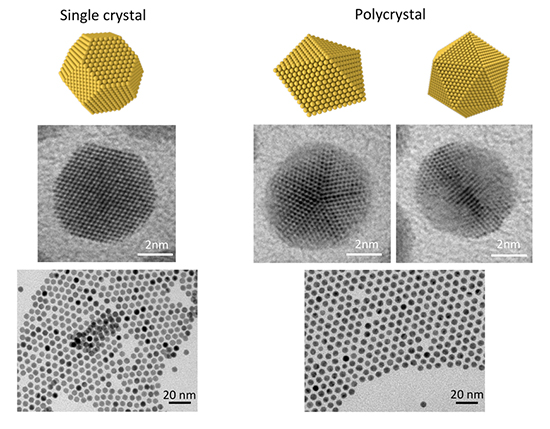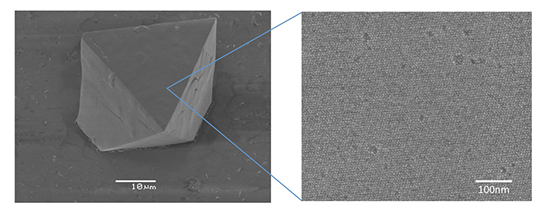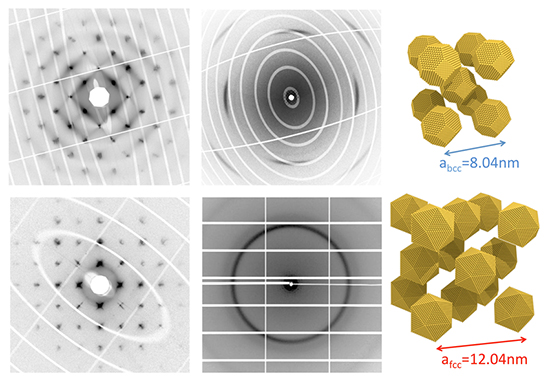Researchers from MONARIS, LPS laboratory and SOLEIL succeeded in crystallizing gold colloidal crystals made of poly- or single-nanocrystals, and their structures have been revealed using the bio-crystallography beamline, PROXIMA1. Their results are published in CrystEngComm.
When gold nanocrystals have a low size distribution, they can self-assemble into three dimensional ordered mesoscopic structures, called “colloidal crystals”. The interest of these colloidal crystals comes from the specific collective properties of the nanocrystals that depend upon their arrangement. Indeed, the periodic organization of nanocrystals in colloidal crystals gives rise to a new class of functional materials where specific properties, different from those of the nanocrystals or of the corresponding bulk phase, can be expected, particularly with plasmonic coupling and electronic properties.
A challenge for the development of technologies based on these materials is to achieve precise control of the self-assembly process. A detailed knowledge of the internal structure of such materials is a prerequisite for the comprehension of their physical properties.
Contrary to quantum dots, and due to their low formation energy, crystal defects such as twins are often present in noble metal nanocrystals. The presence or not of such twins will impact the overall nanocrystal shape. In this study, transmission electron microscopy reveals that the gold single crystals mainly display truncated octahedron shape while polycrystals are observed as icosahedron and decahedron (Figure 1). Due to the difficulty in controlling the twin amount in a face-centered cubic metal, the role of crystal defects remains unclear during the self-assembly of gold nanocrystals.

Figure 1: Single crystals (truncated octahedron) and polycrystals (decahedron and icosahedron) with their corresponding transmission electron microscopy pictures.
Dodecanethiol-coated gold nanocrystals used in this study have a mean diameter of 5nm with polydispersity less than 7% (Figure 1). By increasing their attractive interactions with bad solvent diffusion, gold nanocrystals spontaneously self-assemble into sub-millimetric colloidal crystals. The amount of crystal defects in the nanocrystals was controlled by using a process of crystalline segregation. Large octahedral colloidal crystals were obtained with either poly- or single- nanocrystals (Figure 2). No structural difference can be seen from the high-resolution scanning electron microscopy pictures (Figure 2) between both types.

Figure 2: Typical low and high magnification SEM pictures of gold colloidal crystals made of poly or single crystals.
The wide q-range of PROXIMA-1 allowed collecting diffraction patterns related to the nanocrystal position and orientation within the colloidal crystal. Diffraction patterns of 50µm colloidal crystals were collected on a Pilatus 6M detector which allowed the precise reconstruction of the reciprocal space at the levels of the nanocrystals and of the colloidal crystal (Figure 3). By correlating the order at the nano- and meso- scales, the role of defects in the gold nanocrystal for the self-assembly was demonstrated. The crystal defects present in the icosahedron and decahedron result in a nearly spherical shape of the nanoparticles; they self-assemble on a face-centered cubic lattice without orientational order. On the contrary, single crystal nano-particles (truncated octahedron) self-assemble on a body-centered cubic lattice and orientations of the crystallographic axis of the nano-particles are highly correlated. This structural change, which is opposite to the theoritical predictions, is explained by the role of facets and in particular by the fact that the nanoparticle shape is close to the shape of the Wigner-Zeitz cell of the body-centered cubic lattice.

Figure 3: SAXS (left panels) and WAXS (middle panels) reciprocal space slices obtained from colloidal crystals made of gold single (top panels) or polycrystals (bottom panels) and the corresponding model of nanocrystal arrangements (right panels).
This study demonstrates the importance of crystal defects in nanocrystals during their self-assemblies. The knowledge thus obtained from this study is fundamental to understand the collective properties of colloidal crystals that are highly sensitive to the nanocrystal arrangement.
